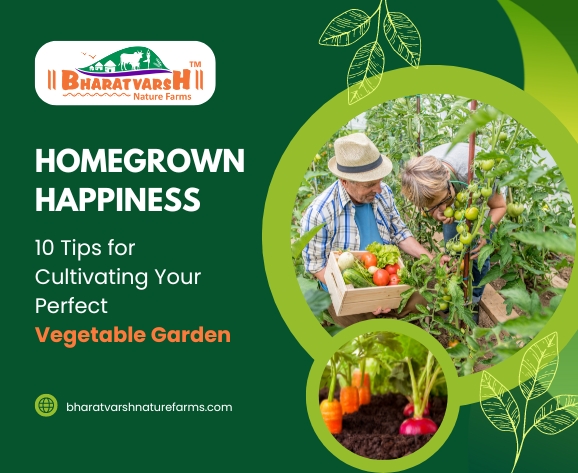Ever dream of biting into a tomato still warm from the sun, its flavor a testament to your own nurturing care? Or tossing a salad bursting with vibrant vegetables you coaxed from tiny seeds? Homegrown vegetable gardening isn’t just about aesthetics (though a flourishing vegetable patch is undeniably beautiful). It’s a doorway to a world of Homegrown Happiness, filled with self-sufficiency, fresh flavors, and a newfound connection to your food.
This guide equips you with the essential knowledge to create your own Vegetable Gardening haven, whether you have a sprawling backyard or a sunny windowsill. We’ll explore ten key tips to cultivate a thriving garden that rewards you with delicious, nutrient-rich produce throughout the season.
10 Tips for Cultivating Your Perfect Vegetable Garden
1. Location: Finding the Perfect Spot for Your Vegetable Garden
The foundation of any successful garden starts with the right location. Vegetables crave sunshine, ideally at least 6-8 hours of direct sunlight daily. Look for a well-drained area that won’t become waterlogged after heavy rain. Avoid spots under large trees, as their roots can compete for water and nutrients, and their shade can hinder growth.
For those with limited space, fear not! Urban Farming thrives in containers on patios, balconies, or even fire escapes. Choose large pots with drainage holes and position them in a sunny spot.
2. Know Your Climate and Growing Zone For Vegetable Homegrown Farming
Not all vegetables are created equal, and understanding your local climate and growing zone is crucial for success. A quick online search will reveal your specific zone, which then helps you choose vegetables that thrive in your region’s temperatures and rainfall patterns.
This knowledge ensures you plant at the right time and select varieties best suited to your climate. For example, warm-season vegetables like tomatoes and peppers won’t fare well in cooler zones, while leafy greens may struggle in scorching summers.
3. Embrace the Power of Planning: Charting Your Garden’s Course
Taking a moment to plan your garden layout goes a long way in maximizing productivity and creating a visually appealing space. Sketch a layout on paper, considering the mature size of your chosen vegetables. Group plants with similar water and sunlight needs together for efficient watering and space utilization.
DIY Garden Projects like raised garden beds can enhance your space and improve drainage. Research companion planting techniques, where certain plants can benefit each other by attracting pollinators or deterring pests.
4. Soil is the Soul: Creating a Nutrient-Rich Haven for Your Plants
Healthy soil is the foundation of a thriving vegetable garden. Ideally, your soil should be fertile, well-draining, and teeming with beneficial microorganisms. If your existing soil feels compacted or lacks nutrients, consider amending it with compost, aged manure, or organic matter like leaves and grass clippings.
A soil test can reveal your soil’s pH level and nutrient content, allowing you to make targeted amendments for optimal plant growth. Remember, happy soil leads to happy plants and, ultimately, happy gardeners!
5. Starting Strong: Seeds or Seedlings – The Choice is Yours
There are two main ways to get your garden growing: starting from seeds or planting seedlings. Seeds offer greater variety and are generally less expensive, but they require more patience and care to germinate successfully. Seedlings, on the other hand, provide a quicker path to harvest and are a good option for beginners or those with a shorter growing season.
Home Gardening enthusiasts often enjoy the satisfaction of nurturing seedlings from seed indoors before transplanting them to the garden once all danger of frost has passed.
6. Watering Wisdom: Keeping Your Plants Hydrated Without Drowning Them
Watering is an essential but delicate balancing act. Underwatering can stunt plant growth and wither leaves while overwatering can lead to root rot. The ideal watering schedule depends on your climate, soil type, and the specific needs of your chosen vegetables.
As a general rule, water deeply when the top inch of soil feels dry to the touch. Early morning watering is best to minimize evaporation and reduce the risk of fungal diseases.
7. Weed Warriors: Maintaining a Weed-Free Garden Paradise
Weeds compete with your vegetables for water, nutrients, and sunlight. Regular weeding is essential for maintaining a healthy and productive garden. The best approach is to hand-pull weeds when they are young and manageable.
Mulching around your plants with organic materials like straw or shredded leaves helps suppress weeds while retaining moisture in the soil.
8. Nature’s Allies: Fostering a Healthy Ecosystem in Your Garden (continued)
Instead, opt for organic pest control methods like insecticidal soap or neem oil. Encourage a healthy ecosystem by planting companion flowers that attract pollinators like bees and butterflies, which are crucial for fruit and vegetable production.
9. The Joy of Harvest: Reaping the Rewards of Your Labor
The true magic of vegetable gardening unfolds at harvest time. There’s a deep sense of satisfaction in picking vegetables you’ve nurtured from seed or seedling. Harvest vegetables when they are ripe and at their peak flavor.
Many vegetables can be harvested multiple times throughout the season if picked strategically. Research the proper harvesting techniques for each vegetable to ensure a bountiful and sustainable harvest.
10. Continuous Learning: The Never-Ending Garden Journey
Gardening is a continuous learning experience. There will be successes and setbacks, but each season offers valuable lessons. Don’t be discouraged by challenges; embrace them as opportunities to learn and improve your skills.
Healthy Eating becomes a delicious adventure as you incorporate your homegrown produce into your meals. Keep a garden journal to track your successes and failures, plant varieties, and harvest times. This knowledge becomes invaluable for future planning and ensures a thriving vegetable garden year after year.
Embrace the Journey
Homegrown vegetable gardening is more than just cultivating delicious food; it’s a journey of self-discovery, connection to nature, and a celebration of Green Living. So, grab your gloves, get your hands dirty, and embark on this rewarding adventure towards Homegrown Happiness.
Conclusion: Cultivating Happiness, One Vegetable at a Time
As you embark on your Homegrown Vegetable Gardening journey, remember, that it’s not just about the destination; it’s about the delicious and enriching journey along the way. The satisfaction of nurturing tiny seeds into thriving plants, the thrill of the harvest, and the joy of savoring the fruits (or, should we say, vegetables) of your labor are truly rewarding experiences.
This newfound connection to your food fosters a sense of Sustainability and self-sufficiency. You’re not just cultivating vegetables; you’re cultivating a deeper appreciation for the natural world and the power of nurturing life.
Whether you’re a seasoned gardener or a curious beginner, there’s a space for you in the world of Vegetable Gardening. Start small, experiment, and embrace the learning process. The rewards are not only delicious but also deeply fulfilling. So, step outside, feel the sun on your face, and let the magic of homegrown happiness bloom in your garden.
Contact us today for any queries! »




